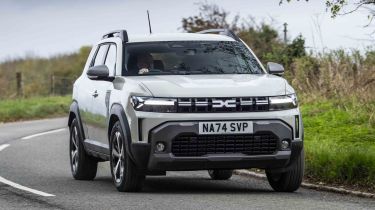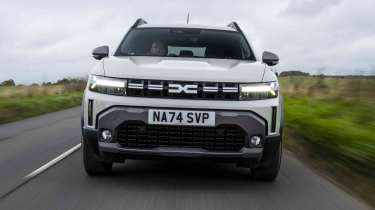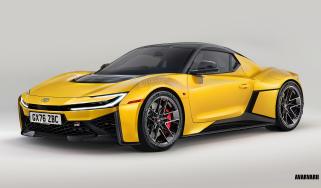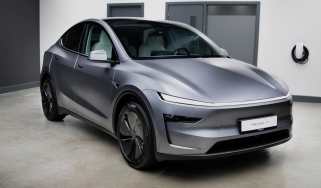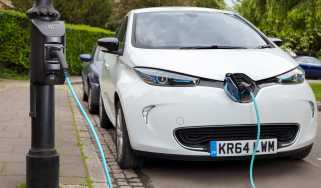Dacia Duster – Engines, performance & drive
The Dacia Duster’s driving manners are fine for a family SUV, but refinement could be better

The big under-bonnet story for the third-generation Duster is that a full-hybrid powertrain makes an appearance for the first time. It’s a unit we’ve already sampled in the seven-seat Jogger, plus a range of Renaults. The 1.6-litre petrol engine is paired to a couple of electric motors: a main 49bhp unit to deal with propulsion, plus another smaller one working on brake regeneration and taking the place of a traditional starter motor. This sends drive through a multi-mode clutchless gearbox, which Renault claims returns fewer driveline losses than more conventional dual-clutch or torque-converter autos. Output stands at 138bhp and 205Nm.
The powertrain that will make sense to most buyers is the more conventional petrol mild-hybrid. The 1.2-litre three-cylinder turbocharged engine makes 128bhp and 230Nm, with drive sent exclusively through a six-speed manual gearbox. This option is available with either front or four-wheel drive.
In a fairly unusual step in the new car market, the Duster, as with other Dacias, remains available with a Bi-Fuel powertrain, which is able to run on petrol or liquefied petroleum gas (LPG), with a tank for each and the on-board electronics managing fuel flow. In the UK, it’s the cheapest option in the Duster line-up and the least powerful; its 1.0-litre three-cylinder turbocharged engine produces 99bhp.
| Model | Power | 0-62mph | Top speed |
| Dacia Duster TCe 100 Bi-Fuel | 99bhp | 13.2 seconds (LPG) 14.1 seconds (petrol) | 104mph (LPG) 101mph (petrol) |
| Dacia Duster TCe 130 | 128bhp | 9.9 seconds | 112mph |
| Dacia Duster TCe 130 4x4 | 128bhp | 11 seconds | 112mph |
| Dacia Duster Hybrid 140 | 138bhp | 10.1 seconds | 99mph |
What is the Dacia Duster like to drive?
The Duster focuses on comfort, which sets it apart from many of its similarly sized SUV rivals. So-so performance and slightly wallowy handling are compromises we’re happy to accept, given the ride quality and low price point, but in some ways it feels like refinement has taken a slight step back compared with its predecessor.
In town
The first thing that strikes you in the new Duster is how softly it rides. Compared with so many rivals that try to trick buyers into a sense of sportiness – when in fact all they’re getting is a hard suspension set-up – the way that the Duster gently wallows from one bump to the next is both refreshing and calming.
More reviews
Car group tests
In-depth reviews
Long-term tests
Road tests
- Dacia Duster 2024 Hybrid review: electrical assistance suits superb small SUV
- Dacia Duster Expression 130 TCE petrol review
- New Dacia Duster Extreme SE 2022 review
- Dacia Duster petrol review
Used car tests
The smoothness of the hybrid powertrain helps here, too; at low speeds and with gentle throttle openings, it feels slick and switches between petrol and electric modes near seamlessly – the one small exception being an occasional grabbiness from the motor regeneration when slowing.
The manual gearbox in the mild-hybrid petrol is fine, but would be improved by a less spongy response from the clutch pedal.
On A- and B-roads
A soft ride means that the Duster isn’t a car that encourages you to chuck it around a series of corners. In fact, it feels a touch more nose-heavy than the last Duster, so it’s not a choice for the keen driver. Driven at a more gentle pace, it’s capable enough and still grips the road well. The steering is quite light and vague around the straight-ahead, but becomes heavier and more precise as extra lock is applied.
The hybrid system feels a little more out of its depth at higher speeds, with that multi-mode gearbox often clinging on to a low ratio for too long after a burst of acceleration or steep uphill section, resulting in a lot of wailing from the four-cylinder petrol engine.
On the motorway
That soft ride makes motorway cruising a relaxing experience. It’s a shame, then, that the Duster’s bonnet and A-pillars throw up a lot of wind noise at speed, to the point where it’s more noticeable than in the outgoing car. It’s a gripe that becomes more apparent because elsewhere it feels like a step forward; road noise is more muted than before, and once the hybrid system settles down, it’s not very intrusive either. The mild-hybrid petrol model is quieter still.
Off road
As with most small SUVs, the Dacia Duster is front-wheel drive as standard, but a four-wheel-drive system is available with the TCe 130. This can handle more arduous terrain than your standard muddy farm track or boggy festival car park.
The Duster 4x4 also comes with a slightly taller ride height and 217mm of ground clearance, while there are drive modes for handling snow, mud/sand and general off-roading, plus hill descent control (which works in forward or reverse) that keeps the car moving at 5mph.
Approach and departure angles have been improved when compared with the last Duster, and the 4x4 system can alter power between the axles for steep descents or precarious climbs. We tried the Duster 4x4 and were amazed at the obstacles it could conquer, even on road-biased all-season tyres.
The infotainment screen can show the car’s slip angles and off-road settings, which is helpful, although we’d like the front and rear cameras to have a higher screen resolution in order to spot obstacles better. We managed to get the Duster to a 25-degree side angle, although we were told that during testing, an angle of 40 degrees was achieved, which is five degrees more than a Mercedes G-Class.
0-62mph acceleration and top speed
The fastest accelerating Dacia Duster is the TCe 130 with front-wheel drive. It has an official 0-62mph time of 9.9 seconds, which is two-tenths of a second faster than the Hybrid model’s time. The extra weight of the hybrid system means that the car’s extra 10bhp isn’t enough to make it the fastest Duster, while the standard automatic gearbox will also have an impact on its time.
Add four-wheel drive to the TCe 130, and rather than boosting traction off the line, this makes it slower, with a 0-62mph time of exactly 11 seconds quoted by Dacia.
The entry-level TCe 100 is the slowest of the lot, although running on LPG instead of petrol does give it a bit of a performance boost. On unleaded it accelerates from 0-62mph in 14.1 seconds, but that time reduces to 13.2 seconds when using LPG.

